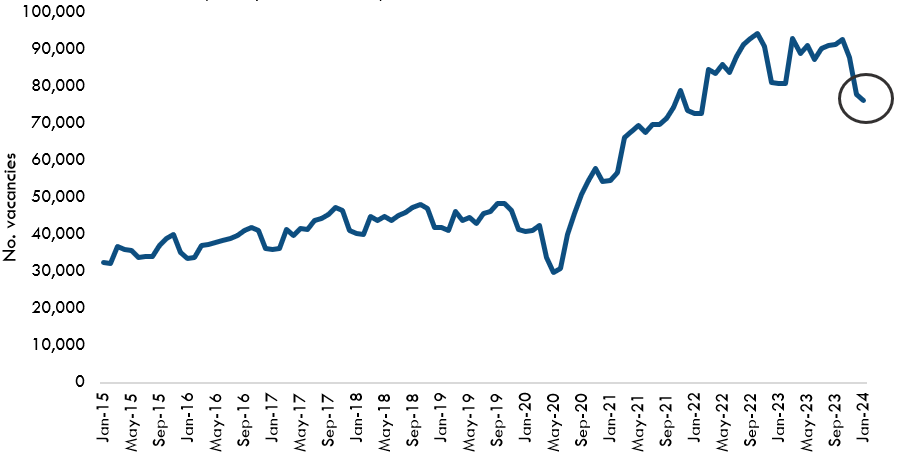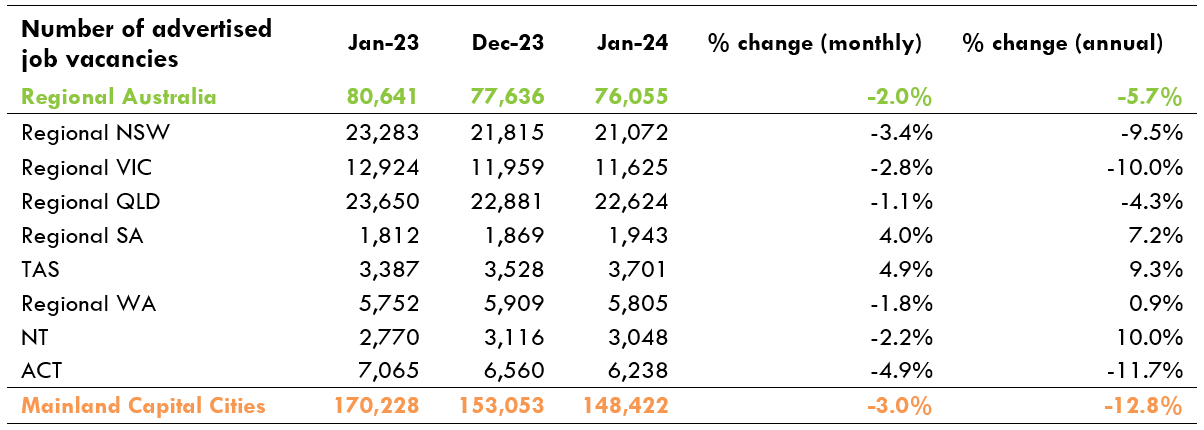Regional Labour Demand
In January 2024, almost 76,000 regional jobs were advertised, marking a 2.0 per cent decrease from the number of vacancies in December 2023. This monthly decline in job ads largely reflects seasonal hiring patterns. The latest number of job ads is 5.7 per cent less than a year earlier.
However, metro areas experienced greater drops both monthly and annually, with decreases of 3.0 per cent and 12.8 per cent respectively.
Regional Australia job vacancies
Jobs and Skills Australia, monthly internet vacancies, RAI

This reduction in the unemployment rate throughout 2022 and subsequent pause for much of 2023 has moved in tandem with the internet vacancy index, which has also held steady for much of 2023.
While across the country there were fewer regional vacancies in January compared to December, the fall was not uniform and Tasmania and Regional South Australia both saw increases in vacancies. The biggest monthly falls were in Ballarat & Central Highlands, Southern Highlands & Snowy, and Tamworth and North West NSW.
The five regions that recorded the largest monthly increases in vacancies in January 2024 were:
- Port Augusta & Eyre Peninsula up by 10.6% (606 compared to 548)
- Hobart & Southeast Tasmania up by 5.9% (2,052 compared to 1,938)
- North West Tasmania up by 4.3% (733 compared to 703)
- Launceston and Northeast Tasmania up by 3.3% (916 compared to 887)
- Fleurieu Peninsula & Murray Mallee up by 1.9% (969 compared to 951)
The annual change in job vacancies across all regions varied significantly, ranging from a substantial increase of 23.2 per cent to a decrease of 19.3 per cent. In comparison, Melbourne and Sydney, the nation’s largest cities, observed the steepest annual declines at 19.3 per cent and 18.1 per cent respectively.
The five regions with the biggest jumps in vacancies in January 2024 compared with January 2023 were:
- Regional Northern Territory up by 23.2%
- Yorke Peninsula & Clare Valley up by 22.9%
- South West WA up by 12.5%
- Hobart & Southeast Tasmania up by 11.0%
- North West Tasmania up by 9.6%
The largest annual falls in regional Australia were in NSW North Coast, Tamworth and North West NSW, and Gippsland.
In terms of the occupations being demanded, vacancies are largest for professional roles (28%) of all vacancies in December, followed by Technicians and Trades roles (16%), and Community and Personal Service roles (14%).
